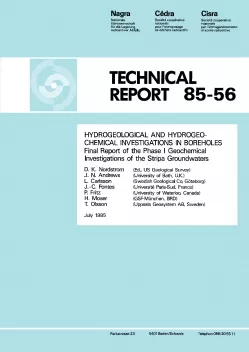
Technical Report NTB 85-56
Hydrogeological and HydrogeochemicalInvestigations in BoreholesFinal Report of the Phase I Geochemical Investigations of the Stripa Groundwaters
The hydrogeochemical investigations of Phase I of the Stripa Project (1980 – 1984) have been completed, and the results are presented in this final report. All chemical and isotopic data on the groundwaters from the beginning of the Stripa Project to the present (1977 – 1984) are tabulated and used in the final interpretations. The background geology and hydrology is summarized and updated along with new analyses of the Stripa granite. Water-rock interactions form a basic framework for the changes in major-element chemistry with depth, including carbonate geochemistry, the fluid-inclusion hypothesis, redox processes, and mineral precipitation. The irregular distribution of chloride suggests channelling is occurring and the effect of thermomechanical perturbations on the groundwater chemistry is documented. Stable and radioactive isotopes provide information on the origin and evolution of the groundwater itself and of several elements within the groundwater. Subsurface production of radionuclides is documented in these investigations, and a general picture of uranium transformations during weathering is presented. One of the primary conclusions reached in these studies is that different dissolved constituents will provide different residence times because they have different origins and different evolutionary histories that may or may not be related to the overall evolution of the groundwater itself.
